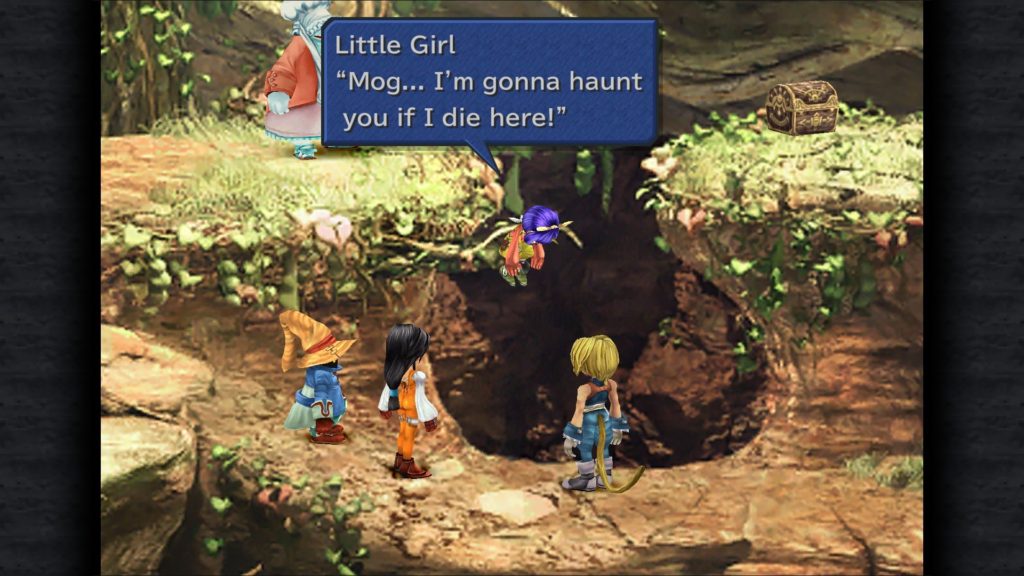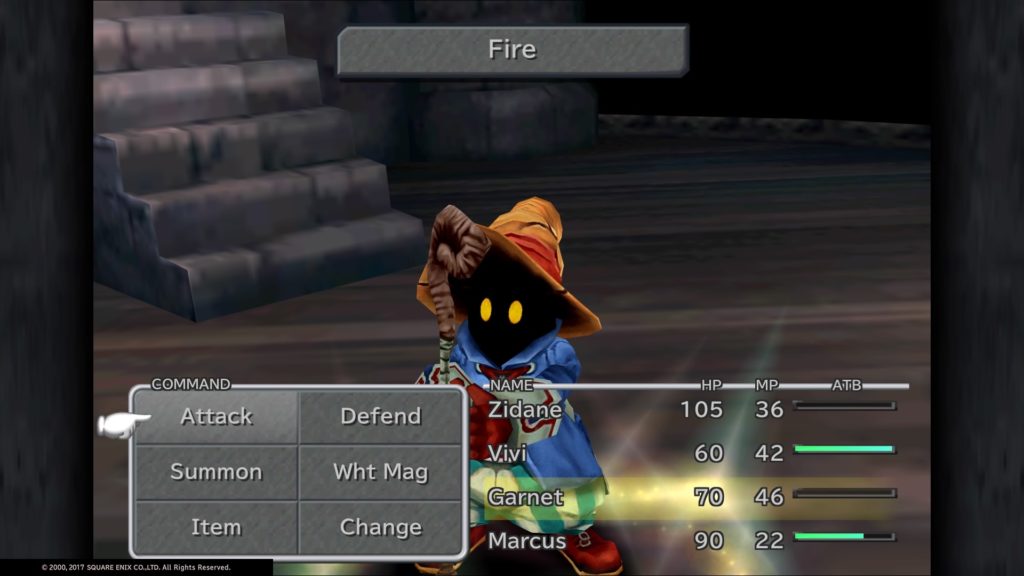There is an invisible consensus that either the sixth or seventh entry of the Final Fantasy franchise is the best one ever. Many have already argued the reasons to support such claim, and, as a fan of the franchise in general, I tend to support most of them. Here, however, I am proposing something different, something which I’ve never thought to be thinking about when I last played Final Fantasy IX around a decade ago.
The first time I got my hands in Final Fantasy IX was in the year 2000, playing a japanese version of the game. I did play the english version early in the following year and would replay the game about five to six years later, but that would be my entire experience with game, perhaps the least replayed classic RPG of my list. Since then I’ve played every entry of the franchise at least twice, sometimes thrice such as Final Fantasy X, Final Fantasy XII, and, of course, Final Fantasy VII. Last year, however, it was time to give one more run with Zidane and his gang, or, as I prefer to say now, Garnet and her minions.
Replaying the game now, as an adult, experienced with so many tales of other games, books, TV Shows, movies, and so on, was a weirdly different experience. For a while, during this new run, I was certain to claim “Hell, there is no way this game can be so good! Did I really play it before?”. Yeah. Of course, as the title of this article says, I ended up my play-through with another opinion, but here I will try to make a stand for the reasons this ninth entry of this beloved series deserves so much more than what it got.
Technical Mastery
First of all, Final Fantasy IX is much like Final Fantasy VI when it comes to technical quality. Why? Simple. Both games were released in the late stages of their consoles, when the development team and community had already grasped the shortcuts and nuances of the current technology. Final Fantasy IX is one of the most stunning games of the Playstation, filled with dozens of locales, charming character models, perhaps the best soundtrack of the series, and some incredible visual effects and CGI scenes. While Final Fantasy VII conquered us for breaking the 3D barrier, Final Fantasy IX was likely the epitome of that age of RPGs.
Two Protagonists
I mentioned this as “Garnet and her minions” because, when replaying the game, it becomes obvious there are two very different scripts in play here. The first one is Garnet’s, the royal princess of Alexandria. Her tale makes use of the Tantalus crew where Zidane belongs, but it is HER tale. This is about her attempts to avoid war and her fight to save her mother from doing a mistake in a lust for power. It is about uncovering her mysterious past. Damn. This is a marvelous tale. It’s got politics, scheming, surprises, and a powerful drama around a girl trying her best to change the world.
This is also supported by a severe dose of “realism”. I mean, although there are flying ships, monsters, and magic, the plot works around a plausible weapon’s dealer corrupting the queen and profiting from war and the misery of others. Garnet works with thieves, former knights, search allies in other kingdoms, and ultimately earns her place in the world. It is a massive departure from the lone adventures of the previous two entries of the franchise, but one that pays off because it has a multitude of charming characters mixing comedy and drama. It’s a combo of classic RPG tropes with a decently weaved tale with a lot of detail and focus.

It has Eiko too
Oh, young Eiko. Although presented late in Garnet’s tale, she is perhaps one of the most incredible characters to join an RPG party. She presents herself as a positive girl living on her own, but she is just eight-years old and the game is spot-on on making you understand she is, in truth, a lonely child in search for friends, companions, and a reason to exist. Her introduction is a mixture of funny and cute moments with innocent sadness. Her role in Garnet’s tale is also important, being the girl that helps the princess to trace back her roots and understand her mission. I don’t remember being so moved by lines of dialogue in a videogame such as in the sweet moments around Madain Sairi and Eiko’s introduction.
It is a consistent classic
Final Fantasy VII was a lot of fun with its Materia system and Final Fantasy VIII had a charming complexity with its Junction and Guardian Forces. Final Fantasy IX goes back to the basic with its Skill system, where you get a full set of slots to equip, dozens of weapons, character jobs, and so on. It doesn’t seem much to brag, but it incredibly consistent with everything else in the game, a thing Square has always nailed in maybe every Final Fantasy Game.
Not only this system seems fitting, but even the large amount of mini-games and side-quests are finely tuned with the game’s theme and style. The chocobo exploration, the auction house, the mid-game events such as the hunt, card tournament, and so on. Final Fantasy IX rarely makes you feel as if content was just put in the game for the sake of giving you more play-time, they all fall naturally to the journey of Garnet and her minions.
So, why does it falls short?
Zidane. I mean, Zidane himself is an amazing character, a carefree thief always jumping around, doing silly stuff, but with a wisdom that comes from living in the shadows of society. He is a guy from the slums and his knowledge is evident and coherent. Sadly though, he also gets a damn weird past and his past becomes the central point of Final Fantasy IX in its second half.
Yeah. Terra, Gaia, another race, dead ancients, sucking energy, bla-bla-bla. After Garnet’s tale is resolved and she gets to play her part as a young queen, the game strives to develop the reminder of the saga by tracing Zidane’s lineage, which puts all those damn terms and typical boring elements into play. Instead of a political warfare with complexity and scheming, the game puts its face in a sci-fi-like storytelling of angry super-villains trying to destroy our world, making the carefree Zidane some kind of chosen-one, the only guy capable of saving everything.
It is a sad departure from a slums thief to a predestined savior of mankind. It doesn’t help that Zidane never had memory of all this weird past, making its late introduction even more lazy and ass-pulled. It is a big fall in quality of storytelling too, losing a lot of time with Zidane questioning his origins and putting the typical “friendship” power as the sole means to make him move on. Garnet’s arc feels a lot more natural than that, miles ahead of it, in fact.

The content
Final Fantasy IX has a lot to do and, as I said, has fitting mini-games and side-quests. There aren’t, however, enough. The game’s super-boss, Ozma, is a letdown for those who wish a real challenge, there is no extra dungeon with some sort of story arc involved, there is no bigger and more complex side-quest to put optional stuff into perspective. While in Final Fantasy VII we had two optional characters with their own big arcs, Final Fantasy IX brings nothing of the kind, just the Moogle Network, which is not exactly a deep dive into Gaia’s story or anything else like that.
Not to say the content is lacking, but comparing to most of the great Final Fantasy games, it seems subpar. It had a lot to explore in this deparment, such as giving more room for Beatrix, perhaps exploring more of Amarant’s past, or simply giving us optional story arcs about the marvelous cities of the game.
It is still one of the best
I said in the title Final Fantasy IX falls short of being the best, but that doesn’t mean it is not a contender. I look at it with different eyes since this last playthrough, yet I now understand better the reasons why, for me, it never reached the level of Final Fantasy VII. Anyway, Final Fantasy IX is a masterpiece and having had the privilege to play it in 2000 and again in 2018 has certainly raised my respect and veneration for it.
